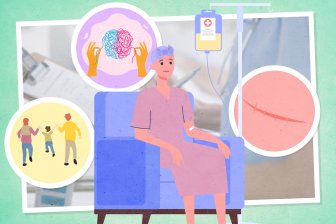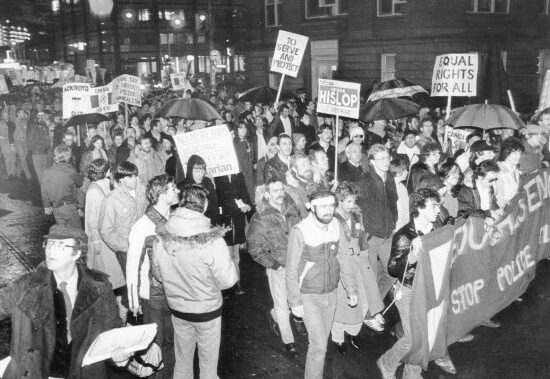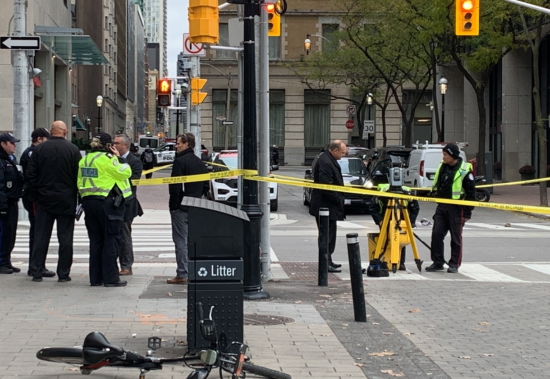
On June 15, James Ramer, Toronto’s interim police chief, sat in front of TV cameras and journalists to deliver an apology to the city’s Black communities.
“We have not done enough to ensure that every person in our city receives fair and unbiased policing,” he said. “For this, as chief of police and on behalf of the service, I am sorry and I apologize unreservedly.”
The press conference was planned to coincide with the release of Toronto Police Service data from 2020 that showed Black residents faced disproportionate enforcement and were more likely to have a police officer point a gun at them.
The data confirmed “a narrative that already exists,” internal police communication plans admit.
Global News obtained the force’s communication strategy for the release of the data through a freedom of information request.
“The public generally knows there is systemic racism at the Service,” one slide from the plan said.
Read more:
Toronto police statistics show disproportionate use of force on Black people
Read More
The data showed that Black people — who made up about 10 per cent of the city’s population in 2020 — faced 22.6 per cent of police enforcement action, which includes arrests, provincial offences tickets, cautions and diversions.
At the same time, 39.4 per cent of use of force incidents involved Black people.
Black people were 1.5 times more likely than white people to have a gun pointed at them when they were perceived to have a weapon and 2.3 times more likely when no weapon was perceived. In both situations, white people were more likely than Black people to face lower levels of force.
East Asian, South Asian and Middle Eastern people were 1.2 times more likely than white people to experience use of force; Latino people were 1.5 times more likely.
The theme of the data’s revelations was not new.
A report by the Ontario Human Rights Commission (OHRC) released in 2020, for example, found that 25 per cent of investigations into police interactions resulting in death, serious injury or sexual assault between 2013 and 2017 involved police interaction with Black people.
During that period, just 8.8 per cent of Toronto’s population was Black.
“The narrative we refer to in our communication plan is around the existence of systemic racism in policing, including at TPS – a narrative that our findings support,” a spokesperson for Toronto police told Global News.
“As the Chief made clear in his remarks, the findings from our 2020 Race-Based Data Collection show that we have not done enough to ensure that every person in our city receives fair and unbiased policing, by confirming that Black, Indigenous, and racialized people are over-represented in both use-of-force incidents as well as in strip searches.”
Akwasi Owusu-Bempah, an associate professor of sociology at the University of Toronto who has closely followed police interactions with racialized communities, said honest, clear and transparent communication was important.
“But boy did this ever fall flat on its face,” he said of Ramer’s apology.
“I just look at how much work has gone into trying to release this data, to present this information to the public and I think how these resources and this time could have been more effectively spent trying to ameliorate the very problems that they’re (bringing) to the attention of the public.
“They’re trying to have justice be seen to be done and people want to see justice being done.”
‘Striking a balance will be important’
When the Toronto police chief told the city empirical data showed his force had a serious issue with systemic racism, the police communications team wanted the public to take away three messages: “accountability, apology and action.”
Ramer and police spokespeople were urged to avoid offering excuses for the data, warning that “any goodwill will be lost if we fail to be open and honest about what the findings mean and present some tangible solutions.”
Another line added, “At this point, the public’s perspective is the issue of racism has been active for a very long time so any indication that solutions are vague or still being thought through will not be well-received.”
It was also important to avoid alienating officers.
The strategy left police trying to speak to two contrasting demographics: the public, which, by the force’s own assessment, was tired of spin, excuses and inaction; and union officials and police officers, who would presumably push back against suggestions they themselves were racist.
“The public is likely to see it as a TPS-specific issue and assume many of its officers are at fault,” a communications slide said. “However, internal audiences, like members, will want to learn more on the system angle. Striking a balance will be important.”
In the end, police brass struggled to do either.
During his apology, Ramer was interrupted by Beverly Bain, with the No Pride in Policing Coalition, who told the interim chief his apology was “insulting to Black people.”
“When you talk about systemic change and you talk about the system, you make it seem as though it’s a structure that’s somehow a separate entity from that of what is happening on the ground,” she said.
“Chief Ramer, we do not accept your apology.”
Ramer, who has been serving as interim chief, will be replaced by Myron Demkiw in December.

The subject of her interjection — the culpability of individual officers for the data that showed police in Toronto treated Black residents differently than white — had been the subject of meticulous preparation for the interim police chief.
A list of 15 “reactive questions & answers” was drafted for the chief ahead of his press conference. Three of them dealt with explanations for why individual officers would not be identified and the perception of ineffective training.
“The Service already has accountability measures in place to address individual racism, which is identified as misconduct,” one pre-written answer from the documents says.
Ramer, through the press conference, shared those talking points, saying the data would not be used to assess or discipline specific officers.
He noted that the data was anonymized and meant to examine systemic racism. There are already internal systems, watchdogs and legal processes in place to deal with officer misconduct, and “overt racism will not be tolerated,” he said.
That preparation, compared with how it landed, was not lost on Owusu-Bempah.
“What is interesting, at least from my perspective, is that chief’s apology fell flat on its face given how much preparation, how much material was developed,” he said.
The Toronto police spokesperson said transparency had always been the key — even if different audiences interpret the data differently.
“We continue to have conversations with all different stakeholders, always with the view of advancing understanding and equity,” the spokesperson said. “We want our members to understand what the findings mean and what we are doing to support them so they can best serve communities.”
Despite the carefully prepared attempt not to condemn officers during the rollout of the data, the force’s union, the Toronto Police Association (TPA), reacted pointedly.
The union distanced officers from the findings, suggesting broader societal failings were at play.
The TPA said while the two datasets “cannot be disputed,” the results are “disappointing and leave more questions than answers, including why disparities exist or what factors could have led to an encounter with police in the first place.”
“Societal failures tend to fall at the feet of officers who police where and when they are directed,” the statement read. “Their actions, often split-second decisions, are then scrutinized with very little consideration given to the organizational shortcomings that occurred long before the interaction with a police officer.”
‘Courtesy heads-up’
Plans to release the data began to roll out at least a month before it was published.
On May 10, the data and its findings of systemic racism, particularly impacting Toronto’s Black community, were presented to the police’s Anti-Racism Advisory Panel and the Police And Community Engagement Review committee.
Neighbourhood Community Engagement Officers (NCO) were engaged, with a focus group convened on May 18. The communications rollout plan says the meeting was to discuss “anticipated community reaction” to the data.
Toronto police also held meetings with “agencies / community leaders” to help explain terminology in its reporting and “seek support from the community.”
The OHRC was briefed, as were the City of Toronto and Ontario solicitor general.

The release of the data was also likely to pile further scrutiny on Ontario police forces, which have been under the microscope in a new way since the 2020 murder of George Floyd.
Two weeks before the data was made public, Toronto’s interim chief sent a brief note to his peers. The communications plan described it as a “courtesy heads-up” to other Ontario police chiefs in which “limited” details would be provided.
An electronic update was sent to all Toronto police members on June 11, laying out activities in June and July, including the race-based data collection and an equity strategy.
The day before the data was finally made public, on June 14, another message was sent to police officers reminding them that “full findings are being released tomorrow” and that “key messages” would be released the next day.
The week after Ramer held his press conference, lasting roughly an hour, the Toronto Police Services Board — the organization that governs the force — passed motions that could move the force away from its attempt to communicate to both officers and the public on its race-based data initiative.
The board passed a set of motions aimed at examining — and potentially expanding — what can be done with the data under provincial legislation and its own policy.
“In terms of identifying specific divisions or individual officers, the intent is certainly to look at whether and how this can be done, respecting applicable law that creates the framework in which this is done,” Ryan Teschner, the board’s executive director and chief of staff, said in an email.
The board will then look at that assessment and review its policy on race-based data, Teschner said, adding that the motions “contemplate a situation in the future where such analysis could be possible, respecting the legal framework.”
When it adopted the policy in 2019, the board said the data would not be used to identify specific officers or manage their performance, but to “identify trends that contribute to professional development and organizational change.”
Ontario’s privacy commissioner clarified that the law does not prevent police from using the data to assess and discipline individual officers.
“Our approach to using RBDC data to identify individual officers has not changed,” the Toronto police spokesperson said.
Toronto police told Global News the next stages of its plan will begin rolling out soon.
The force is expected to release an academic report on the findings, including further data, such as breakdowns by gender.
“Although there is much more work to be done, the strides we are making demonstrate our commitment to transparency and accountability, and to strengthening trust with all of Toronto’s many communities,” the spokesperson said.
— with files from The Canadian Press
© 2022 Global News, a division of Corus Entertainment Inc.

















